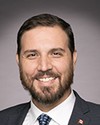Could we get clear about exactly what the business model is?
How is it that you have been able to take the subject matter expertise as a frontline physician and recognizing, hopefully, the support and the need for the privacy of health information, even in the instances of pandemics...? In which way did you find this an opportunity where there could be commodification in a profit model or motive for this particular point in time?




